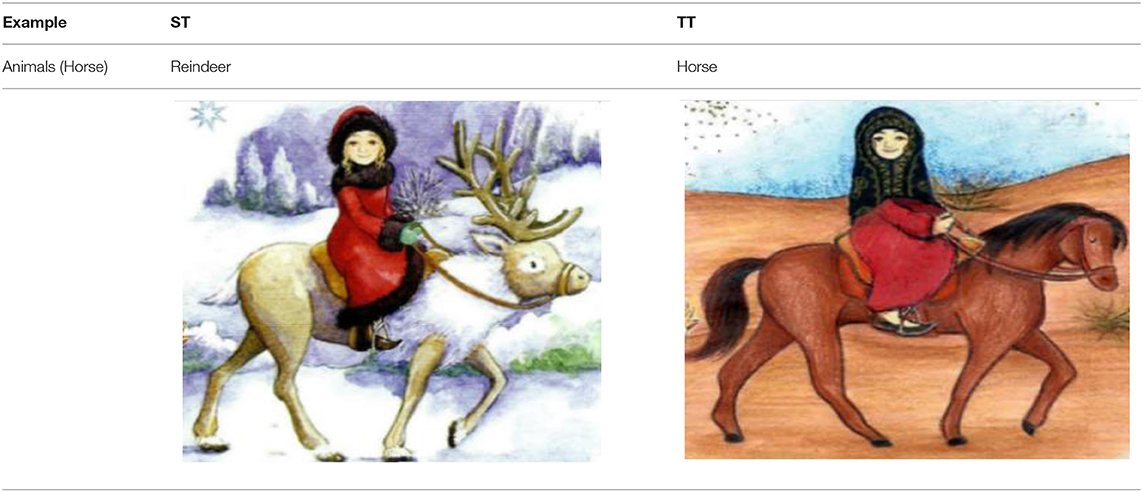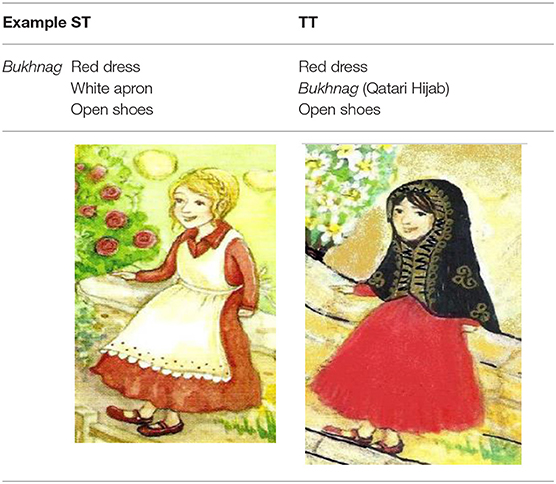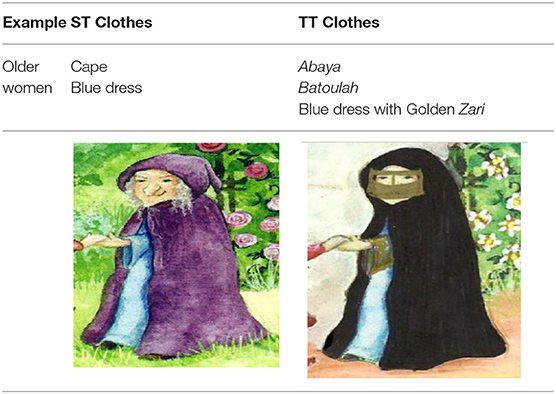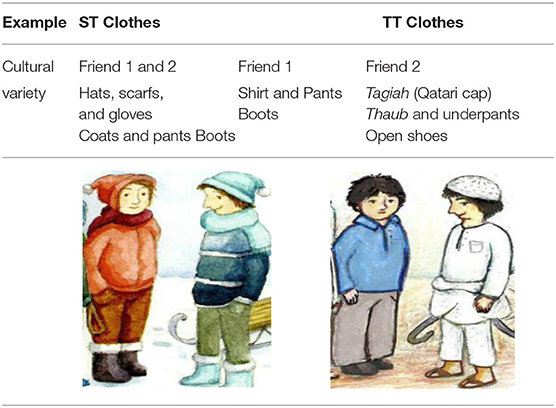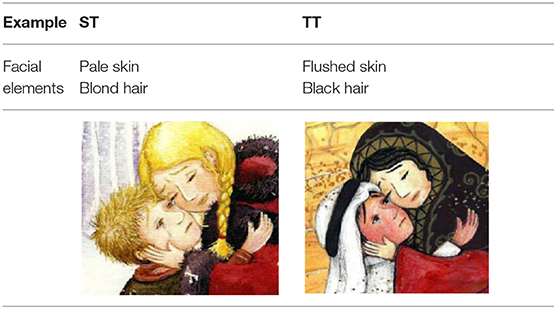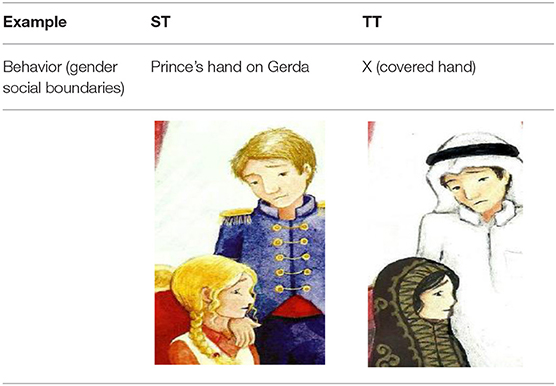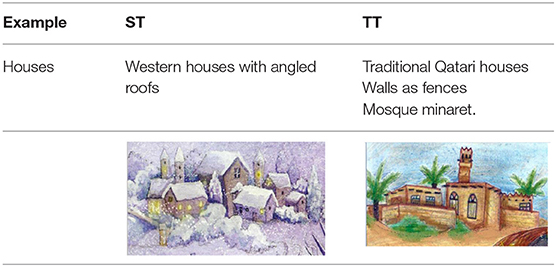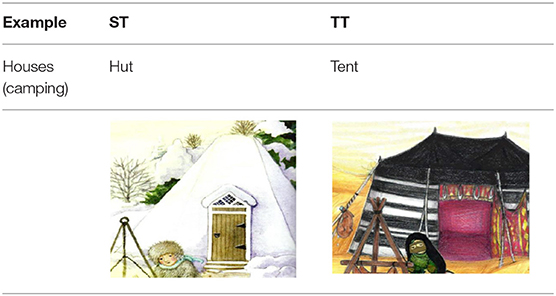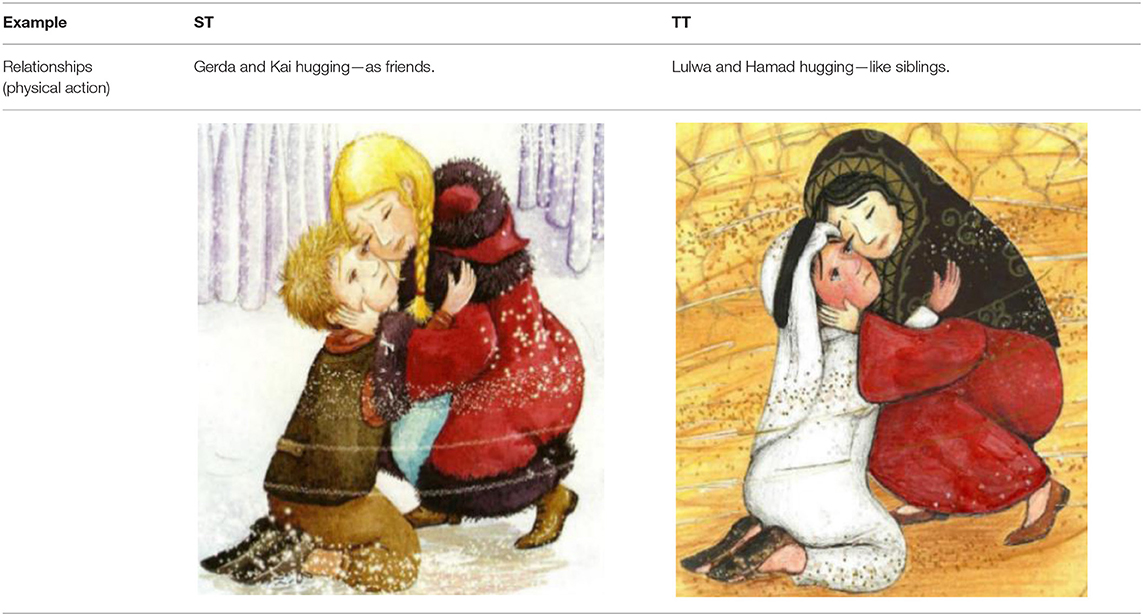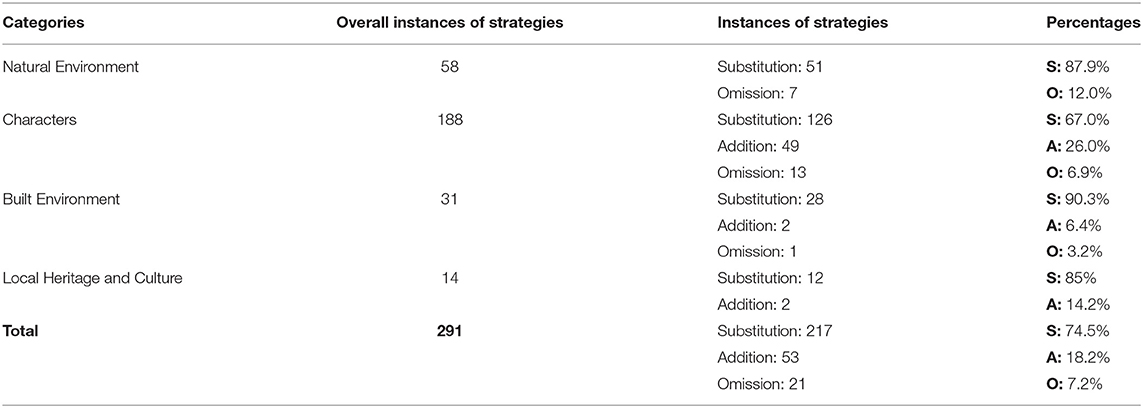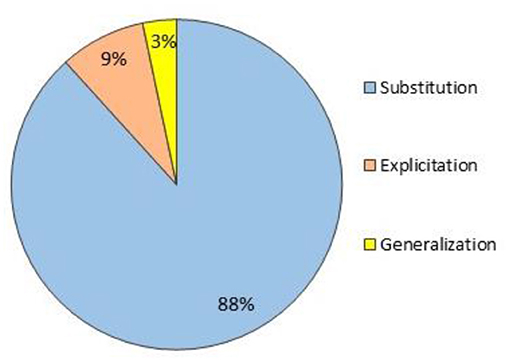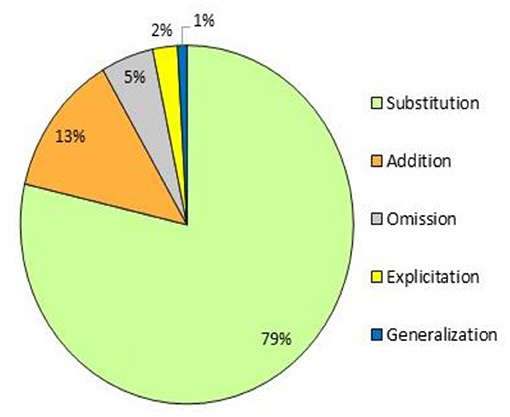- 1Translation and Interpreting Institute (TT), Hamad Bin Khalifa University, Doha, Qatar
- 2Qatar University Press (QUP), Doha, Qatar
This paper discusses a project that aimed at providing a visual and verbal transadaptation of the Western classic fairytale, The Snow Queen, into the Arabic Qatari culture. The illustrations were creatively transadapted to provide Qatari-specific imagery, and the verbal text was translated from English into Modern Standard Arabic while using the Qatari dialect for direct speech to make the text Qatari-specific. The new version, ملكة الصحراء (The Desert Queen), aims to reinforce Qatari children's national identity through the preservation and promotion of the Qatari culture and dialect, both currently affected by globalization. This paper also looks into the analysis of the transadaptation. All changes are categorized according to Newmark's cultural categorization and further analyzed in terms of the strategies used following Pedersen's model for rendering Extralinguistic Cultural References. The analysis shows how the strategy of substitution prevailed both in the visual and verbal components of the transadaptation, making it the main factor of domestication. This case study introduces some fundamental notions and techniques of transadapting any picture book for a specific culture or audience. Furthermore, this experience speaks of the relevance of preserving and promoting local culture as previewed by Qatar's national vision (QNV-2030).
Introduction
Qatar is a developing country that currently focuses on modernization and reinforcing cultural exchanges. As a result, the young Qatari generation knows more about other cultures than its own, which may lead to the loss of the Qatari identity. Qatar's National Vision (QNV-2030) is geared toward preserving the Qatari culture and promoting it across other cultures (Ministry of Development, 2018). It is also stated in Qatar National Vision 2030 that “Preservation of cultural traditions is a major challenge that confronts many societies in a rapidly globalizing and increasingly interconnected world” [Qatar National Vision (2030), 2008, p. 8]. With this in mind, the project discussed below aims to support the preservation of the dominant Qatari identity by targeting the young Qatari readers, to highlight what is unique to the culture.
The journey of transadapting The Snow Queen, as retold by Williams (2017), into The Desert Queen started with the question: “How might a Western picture book be transadapted to become Qatari-culture centered?” This question led to addressing transadaptation at a micro (verbal and visual) level and a macro (cultural) level. To start the transadaptation process, the source text (ST) was analyzed to identify and categorize the cultural elements that needed to be domesticated into the Qatari culture, proceeding to recreate the visual transadaptation (illustrations). The verbal text was translated into Modern Standard Arabic (MSA), changing cultural references where needed, and using the Qatari dialect for direct speech to add a local flavor. In parallel, adjustments were made to the illustrations, to make the visual components relevant and appropriate to the target culture.
The outcomes were then analyzed in light of two theoretical constructs: the visual and verbal components were categorized according to Newmark's (1988) model of cultural categories, then the diverse visual and verbal components were analyzed using Pedersen's (2005) model for rendering extralinguistic cultural references.
Children's picture books are multimodal visual literature that combines art and literature (Salisbury and Styles, 2012, p. 7). Oittinen (2000, p. 5), Zitawi (2008, p. 140), and Salisbury and Styles (2012, p. 7) claim that the visual elements in child-directed narratives can be more important than the verbal. When it comes to translating picture books, the written text is not the only mode to be translated. Oittinen (2000, p. 75) states that “translators of picture books translate whole situations including the words, the illustrations, and the whole (imagined) reading-aloud situation.” Oittinen (2000, p. 100) also affirms that translating images is as important as translating words for producing a full translated text.
For foreign Children's Literature to be transadapted into local culture, domestication is required. Venuti (2001) discusses domestication as a translation strategy, which depends on the “reconstruction of the cultural formation in which the translation is produced and consumed” (p. 234). Venuti (2001, p. 241) defines domestication as a conservative translation strategy that makes the text serve specific domestic agendas, and that is qualified by current political and cultural developments that dominate the target culture. Domestication can help in reinforcing the national identity and preserving culture, values, and beliefs that construct societies. Thus, the decision to transadapt a text to bring it closer to the target readership's culture would fall under the category of domestication.
Transadaptation is frequently used in Audiovisual Translation (AVT). AVT is known as the translation of the verbal content that is supplemented by other elements, such as sounds and images, which “take(s) target audiences into consideration more directly” (Gambier, 2003, p. 171). According to Al-Wahabi (2003, p. 11), most film winners for Best Picture by the Academy of Motion Picture between 1995 and 2008, were adaptations. Gambier (2003, p. 174) explains a possible reason for these adaptations' success, by describing adaptations of films as remakes: “a recontextualization of a film in accordance with the values, ideology and narrative conventions of the new target culture,” which focuses on cultural issues more than language.
Cultural adaptations of multimodal texts, such as films, mainly focus on making a text accessible for a new target audience. In this project, a children's picture book—which uses the visual and verbal media to form a whole experience—was culturally transadapted to become accessible for a completely different audience. Neves (2022) defines the term “accessible translation” as a way “to address translation types that are focused on the requirements of receivers with specific needs.” This scholar may have had persons with disabilities as her main focus, but these could also be young children who need to relate to their cultural surroundings and build their identities. Of course, the process of translation—for access—does not only include translation, in fact; “translation is only one component of the accessibility whole. It will always need to be addressed alongside other components, to be effective or simply to understand itself” (Neves, 2022). Neves (2022) also discusses transadaptation, where adaptations to an original text are made given the specific needs of particular addressees; also, transcreation, when an original text is reformulated within significant degrees of subjectivity and creativity; or, that it can lead to the creation of new realities and materialities that allow for comparable experiences, via new texts that may be distinct.
Of course, adapting or interpreting an ST to make it accessible and appropriate for the target culture, would result in having differences between the ST and the target text (TT), which might be considered an issue concerning faithfulness and loyalty, as mentioned by Oittinen (2000, p. 84). However, Albrecht-Crane and Cutchins (2010, p. 14) believe that “these kinds of differences are not incidental, but rather foundational,” and that “the operative assumption in adaptation studies should be ‘difference,' rather than the usually invoked ‘sameness”' (Albrecht-Crane and Cutchins, 2010, p. 16). The acceptance of differences between ST and TT is based on the idea of “intentionality”, since the transadaptor is adapting a text—intentionally and purposefully—to create new audiences.
Interestingly, the concepts of art and creativity have been linked to transadaptation. Remael and Logie (2003, p. 13–14) claim that translations create new texts through the process of rewriting them. As translators translate themselves and certain aspects of their cultural views into the TT and therefore, present their translations as creative works for a specific audience. To pursue the creative aspect of transadaptations further, Pedersen (2014, p. 57) states:
Extensive adaptations are often called for in this context, and this seems to have led to the genesis of a concept that is often described both as a kind of translation and in opposition to translation, as “more than translation:” transcreation.
In simpler terms, these will be “adaptations so creative that they are regarded more as transcreations than translations” (Pedersen, 2014, p. 58).
Methodology
The transadaptation process took place in consecutive stages. Firstly, the ST was analyzed to identify and categorize the cultural elements that needed to be domesticated into the dominant Qatari culture. Then, the visual component of the picture book was recreated manually, that is, by superimposing the transadapted elements using a corrector to cover certain parts and drawing over them, or by cutting out and gluing on the newly drawn elements to form a complete illustrated page. The process was only complete after adding finishing touches and cleaning the illustrations digitally.
The practical component of this project was followed by a thorough analysis of the procedures to understand the elements that warranted transadaptation. Two distinct theoretical frameworks proved valuable to the analysis of the changes implemented in the new text: Newmark (1988) and Pedersen (2005), even if they were both particularly relevant to verbal translation.
Newmark (1988) claims that cultural words or concepts can cause translation problems, suggesting that a translator ought to find cultural equivalents to convey the meaning to the target audience. Newmark (1988, p. 95–103) describes five cultural categories where words or concepts can differ between cultures:
1. Ecology,
2. Materials and artifacts,
3. Social culture,
4. Organizations, activities and concepts, and
5. Words describing gestures and habits.
Taking Newmark's (1988) categorization of cultural elements into account, the changes made to the original text were addressed and listed under:
1. Natural environment,
2. Built environment,
3. Characters,
4. Local Heritage and Culture, and
5. Linguistic Issues (for the verbal component).
Pedersen's (2005) model of Extralinguistic Cultural References (ECR) is particularly useful for the analysis of the strategies used to domesticate the visual and verbal components of the original story. Although Pedersen's model is originally made for subtitling, it can be used in this multimodal project given that the strategies are equally applicable to static images. Pedersen (2007, p. 30–31) defines ECRs as “expressions that refer to entities outside language, such as names of people, places, institutions, food, customs, etc., which a person may not know, even if s/he knows the language in question.”
Pedersen's (2005) ECR identifies four types of translation strategies that were found in this project:
1. Official equivalent,
2. SL-oriented strategies (retention, specification, and direct translation),
3. TL-oriented strategies (generalization and substitution), and
4. Omission.
Data Analysis
This section looks into the transadaptation process of the visual and verbal components, analyzing the strategies and discussing the reasons behind the main cultural changes.
Visual Component
A comparative analysis between the visuals of the source text (ST) and the target text (TT) will yield interesting insight as to the type of changes implemented to the illustrations to make them more relevant to the new readership's cultural and contextual reality.
Domesticating the natural and the built scenery provides a glimpse of what Qatar used to and, sometimes, still looks like. In the visual transadaptation of the story, I started by adapting the natural environment, as it harbors the most noticeable and impactful elements in the story, such as the weather, geography, and animals. Then, the focus was shifted to transadapting the human characters' appearances, proceeding to change the built environment by domesticating more specific and detailed elements into the Qatari culture, such as houses and objects. Lastly, specific elements of local heritage and culture were addressed.
Starting with the natural environment, the original story is presented between winter and the coming of spring. In winter, the weather is described verbally and illustrated visually as being cold. The winter season was changed to become summer in the transadapted version since Qatar is known for its hot weather that determines the Qatari environment. Other weather features were also adapted, such as substituting the snow storms with sand storms (see Table 1).
The ST's illustrations reflect the Western geography during winter and spring. According to Mohammed Al-Sada: “first impressions of the peninsula (Qatar) are of a flat, barren, sandy desert surrounded by shallow seas” (as quoted by Gillespie, 2006, p. v). Sand, therefore, is the most occurring element in the transadaptation. It substitutes most of the greenery and snow in the ST. Moreover, big trees such as pine trees are substituted by palm trees that are commonly seen in Qatar (Al-Khori) (see Table 2).
Animals are considered a part of the natural environment since they accommodate the settings and give an idea of the ST and TT's environment and culture. In the ST, we see animals that are associated with cold weather, such as polar bears, which are used as means of transportation within the ST, and in the TT these bears are substituted by camels. According to Gillespie (2006, p. 65), Bedouins and camels “lived in a symbiotic relationship in which each was important to the existence of the other.” Horses are also valued by Arabs and are used for transportation (Beardwood, 2008, p. 74). Accordingly, they were used to substitute reindeers (see Table 3).
In this project, the cultural transadaptation of the illustrated characters mainly affected appearances. People, in general, have specific personality traits and characteristics that give away their origins, cultures, and ways of living. According to Hladíková (2014, p. 25), “crafting a believable character is imperative for the success of any picture book.” In this case, I tried to make the transadapted characters become Qatari individuals that are recognizable through their overall appearance and smaller details, namely through their attire, facial elements, and behaviors.
Clothing, to some extent, can indicate a person's specific religion, culture, style, status, and overall dominant social identity (Purpose of Clothing, 2018). According to Al-Wahabi (2003, p. 7), traditional Qatari clothing has been determined by factors, such as religion, tradition, weather, and geography, which were duly considered while transadapting the foreign story for the Qatari culture.
One of the traditional Qatari clothing items is the bukhnag [bukhnag], which is a traditional Qatari hijab variety that is worn by young girls ranging from seven to the age of twelve (Al-Wahabi, 2003, p. 40). The bukhnag is described by Al-Wahabi (2003, p. 48) as a “translucent hijab covering the head and shoulders. It surrounds the face to the underside of the chin, and extends at the front down to the waist.” It is also known for its golden zari [zary] (synthetic threads) embroidery (Al-Wahabi, 2003, p. 48–49). Since the bukhnag is for young girls, it was consistently illustrated on the main character, Gerda in the ST, and the robber-girl who are the only young girls in the story. The bukhnag can be seen in the TT on Gerda, in 14 instances (see Table 4). The bukhnag is added when Gerda's hair is uncovered or is substituting Gerda's hat.
Most of the female dresses in the ST are not specific to any culture, therefore, they are mostly retained in the TT. The females who are wearing dresses in the ST are Gerda, the princess, and three old women. For instance, The princess's and the three old women's dresses are retained while adding minor Qatari specific touches, by adding decorations of golden zari threads on the cuffs (see Table 5). Al-Wahabi (2003, p. 9) claims that “embroidery is perhaps the most remarkable feature of traditional costume.”
The abaya ['bāya] and Sheilah [shayla] are women's traditional black clothing used to cover the body when going out in public, as the Arabian Gulf women's way of following Islamic regulations of modesty (Al-Wahabi, 2003, p. 40). The characters that wear the abaya are two of the older women since both were outside their houses (see Table 5). The older women are also wearing the Batoulah [baṭu:lāh] which is a golden face-mask worn by elderly women; an impactful cultural item.
Most of the male characters' clothing in the transadaptation is substituted with a thaub [thaub], a long white garment that is considered the standard outfit for men. The thaub is shown on all the male characters in the TT, except for one of Kai's (male main character) friends. The thaub is substituting the clothes of Kai, the sorcerer, Kai's friend, the prince, the king, the 5 robbers, and the coach driver. Kai's friends and the coach driver are minor characters in the ST, but they happen to reflect an important Qatari feature in the transadaptation: Qatar is a multiethnic country where people of different origins and cultures live together. To reflect this cultural variety, I decided to illustrate clothes that are not Qatari specific and can be associated with many other cultures and nationalities, giving a more realistic reflection of the Qatari society (see Table 6).
The characters' appearances in the transadaptation are changed to be culturally centered since Qataris—as Arabs—have specific personality traits. For example, the characters' variant hair colors in the ST are substituted with black or dark brown hair. Also, an important facial modification took place when, in the original ST, Kai's skin and hands were transadapted from being pale from coldness, into being red to give the impression that he is flushing from the heat in the TT (see Table 7).
Moreover, the Western and the Arabic Qatari cultures differ in the way they view and portray people's manners, behavior, and social rules. In Islamic cultures, men and women do not shake hands or touch unless they are family, and this is considered a respected “social rule” (Traveling in a Muslim Country, 2018). In the ST, we see the prince putting his hand on Gerda's shoulder, which is unacceptable in Qatari society. Therefore, the prince's hand was omitted in the transadaptation to reflect the practiced Islamic sharia in the Qatari society (see Table 8).
The Western houses in the ST are substituted with traditional Qatari houses. Traditional Qatari houses are characterized by their rectangular-shaped roofs with wooden sticks/beams protruding from the sides (Gillespie, 2006, p. 35), and gates that are made of wood studded by nails (Gillespie, 2006, p. 54). Mosque minarets are also illustrated in the TT to emphasize Islamic features. Qatari houses are surrounded by walls to ensure privacy; hence, walls were illustrated to substitute fences (see Table 9). Another substituted element is the hut. Since huts are used for camping outdoors, the ST's hut was substituted with a traditional tent (see Table 10).
There are other cultural references in the transadaptation that are directly related to Qatar. The Qatari flag on the Zubarah fort is what places the story in Qatar. The Zubarah fort can still be seen and visited today in Qatar and is considered a historical venue. The traditional dahrooj game is played in schools' cultural events. The sado patterns are used in different kinds of furniture. Most Qatari houses today, especially in their Majlises (guest houses), are decorated with sado as a timeless signature decoration of Qatari homes.
Some of these traditional elements could be found in other Arabic countries, especially in the neighboring Arab Gulf countries. With that said, each element has small details that make it specific to Qatar only, such as the Thaub's collar and cuffs or the Ghutra's color or folding, the Bukhnaq's length, and zari patterns, as well as the character's names. The landscapes are also different, Qatar has no mountains, while neighboring countries do. Of course, all of these small details are put into account and are inspired by Qatar's traditions and imagery, while explicating the TT's settings by using the Zubarah fort and the Qatari Flag.
Verbal Component
Renderings and changes implemented in the visuals directly influenced and dictated changes in the verbal text. This is because this story is a picture book formed by verbal and visual texts that depend on each other in conveying the content of the story (Salisbury and Styles, 2012, p. 29).
The characters in the ST have Western names mentioned in the verbal text, which had to be changed into traditional and common Qatari names to reinforce and reflect the Qatari identity of the characters. Gerda's name was substituted with the Qatari female name “ةلولو” [Lulwa]; meaning “Pearl”. This name is considered a traditional, yet still a very common name in Qatar and some Arab countries (Mohammed, 2018). Though it means that the character's beauty is comparable to a pearl's, it is mostly used to reflect upon Qatar, a pearling country in the past. Kai's name was also substituted with the Qatari common male name ”حمد” [hamad]. “Hamad” is a traditional Arabic name that has a religious meaning: “thankful to God” (Al-Sandobi, 2018). It was chosen due to the popularity of the name in Qatar, and to reflect the Islamic religion and its impact on the construction of the Qatari identity.
In the ST, Gerda and Kai are close friends who like to spend time together. As previously mentioned in the visual transadaptation, the Qatari society attaches great importance to the public separation of genders, family relations, and privacy (Culture of Qatar, 2019). This led to substituting the concept of friendship with kinship, which holds more value and importance in the Qatari culture and to Qatari individuals. Thus, Gerda and Kai—Lulwa and Hamad—are transadapted to become a sister and a brother (see Table 11). The TT is a Qatari story that is meant to convey Qatari values, traditions, and principles to children who are still learning about their society.
It was encouraging to transadapt friendship into kinship to deal with verbal expressions and physical actions of love. In the ST (see Table 12), the verbal text mentions that Gerda and Kai love each other as much as a brother and sister. The concept of love between unrelated males and female is sensitive to the conservative Qatari culture, and it would be inappropriate and disrespectful to mention it in a Qatari-oriented tale for children. Thus, this sentence is generalized into “loving each other a lot” after transadapting Gerda and Kai to be siblings, making their love for each other justifiable as a brotherly love that is valued and encouraged.
In addition, in the ST, it is expressed visually and verbally that Kai and Gerda are hugging each other. It was opted to emphasize the fraternal relationship in the verbal text to justify the visual position of Kai and Gerda (see Table 13). This was done by explicating the pronoun in “hugging her”, by saying: “hugging his sister”. According to Oittinen (2000, p. 109), “not only do pictures influence words, but words also influence pictures: different words give the reader a new point of view regarding the illustrations, too.” This interconnectedness is illustrated in the following tables.
The emotional states of the characters in the ST are often described mostly with metaphorical expressions and concepts of coldness, using words like “cold, ice, freeze, and frozen”. As seen in Table 14, describing a person as being cold or having a cold heart, means that he/she does not feel empathy and is harsh and uncaring. To convey a similar message to the target audience, these instances were transadapted by substituting the concept of coldness with rigidity and harshness by using “stones” as the transadapted metaphorical reference. Describing hearts as stones gives the impression that a person is apathetic. Moreover, stones refer to the Qatari natural environment, just like how coldness and ice refer to the ST's Western natural environment.
Code-Switching
Another approach of transadapting the verbal text is through using code-switching from Standard Arabic into the Qatari dialect. Code-switching is defined by Heller (1988, p. 1) as the use of more than one language or language variety in a course of communication. It is claimed that code-switching can provide clues for knowing the social identity of the speaker (Gardner, 2009, p. 42). For instance, switching between using a standard language and a colloquial dialect would give information about the speaker's social identity, and can give the speaker a sense of belonging to a specific society and culture.
Code-switching between Modern Standard Arabic (MSA) and the Qatari Arabic dialect was implemented to link the narrative to the Qatari lifestyle. This is achieved through using local dialectal words and expressions. For the dialect to be distinguished from MSA, the main English narration was transadapted into MSA, while transadapting the characters' speech/dialogues into the Qatari dialect, so whenever there is a direct quote in the story, it is rendered in dialect. This would give a more realistic reflection of the Qatari society, which uses MSA in formal speech and the dialect in informal dialogues (Gamal, 2008, p. 6). Also, since the intended readers of the TT are children, simple and common Qatari terms that are easy to understand were used. According to Gamal (2008, p. 6–7), Arabic translators need to specialize in the colloquial Arabic variety, especially if they are “required to work on translating children's literature, comic books, comedy shows or even TV commercials where the colloquial would be the more appropriate variety of Arabic” (Gamal, 2008, p. 7).
Some of the common dialectal phrases are introduced in the TT. According to Samarin (1976, p. 86), religious communities adhere to a set of practices and beliefs. These communities are also set apart linguistically through their use of religious-linguistic variables that intersect with languages, such as the daily recitation of mealtime prayers and blessings, or the use of swear words that mention God, hell, and the devil. In the ST, some direct speech instances were substituted with common dialectal phrases that mention God in the TT. For instance, the prince and the princess said to Gerda: “We hope you find your friend,” which is transadapted into “إن شاء الله تلقين أخوج” [God willing (inshallah), you will find your brother]. These linguistic instances embody the importance of religion in constituting the Qatari identity, language, and lifestyle.
Transadaptation Strategies
In the desire to understand the nature of the changes and the approaches taken when aiming to make The Snow Queen culture-specific to Qatari readers, Pedersen's (2005) Extralinguistic Cultural References (ECR) strategies were used. The changes made to the ST amounted to a total of 410 instances of transadaptation of both visual and verbal elements (see Table 17).
The visual transadaptation has a total of 219 instances (see Table 15), which implied the use of three Extralinguistic Cultural References (ECR) strategies: Cultural Substitution, Addition, and Omission (Pedersen, 2005). In quantitative terms, 75% of the transadapted visuals were substituted with target culture-specific elements, 18% of the elements were added, and only 7% of the elements were omitted (see Figure 1).
The verbal transadaptation comprises 119 instances (see Table 16), using another set of three ECR strategies: Substitution, Explicitation, and Generalization (Pedersen, 2005). In this case, 88% of the transadapted verbal instances were substituted by culture-specific elements. Nine percentage were explicated and only 3% are generalized (see Figure 2).
The above figures of the strategies applied, show that cultural-substitution is the most used strategy in both the visual and verbal components, amounting to 322 visual and verbal instances, which constitutes nearly 79% of the whole transadapted picture book (see Figure 3; Table 17).
Pedersen (2007, p. 35) considers cultural-substitution as a TL-oriented strategy that is the most domesticating when rendering cultural instances, “in that it completely removes a foreign element and replaces it with a domestic one.” This allows us to conclude that The Snow Queen is domesticated into the Qatari culture by substituting the source Western elements with Qatari/Arabic elements.
The second most used strategy is addition, which is used on 53 visual instances, representing 13% of the whole TT. Addition is a sub-strategy of specification, a SL-oriented strategy. According to Pedersen (2005, p. 5), “by using this strategy (addition), the translator intervenes to give guidance to the TC audience.” Addition is originally seen by Pedersen (2005) as a SL-oriented strategy that is used to clarify the source cultural elements for the target audience. However, this strategy is used to domesticate by adding Qatari attire-elements, such as the bukhnag, sheilah and ghutra, to explicitly present the characters as Qataris.
Omission is used in 21 visual instances, resulting in removing 5% of the ST. It is considered a TL-oriented strategy that means removing an ST cultural element. It is considered the only viable strategy to be used in certain circumstances (Pedersen, 2005, p. 9), as these are elements in the ST that are considered “unsuitable” for the Qatari culture. For instance, the prince's hand that was touching Gerda's shoulder was removed, which is considered inappropriate for the Islamic conservative Qatari culture.
Explicitation is used in only 2% of the whole transadaptation, which consists of 10 verbal instances. Similar to addition, explicitation is a sub-strategy of specification that is used to clarify the source culture and to disambiguate an ECR for the target audience (Pedersen, 2005, p. 4–5). Certain verbal instances, such as pronouns, were explicated for the benefit of the target audiences that consist mainly of children who need the text to be clear and easily understood. For instance, the explicitation is applied when mentioning the names of the Qatari characters, such as Lulwa and Hamad.
The least used strategy is generalization that is only used in 4 verbal instances, which resulted in it being used on only 1% of the TT. Generalization is a TL-oriented strategy described by Pedersen (2005, p. 6) as the replacement of an ST element that refers to something specific by something more general. For instance, generalizing “kiss” into “spell”, as the word “kiss” is considered inappropriate for the Qatari audience, and thus demanded replacing it with its original and general meaning, “spell”.
Overall, it is shown that the TT is domesticated mostly through cultural substitution while adding Qatari elements and omitting Western culture-specific elements to produce a Qatari-centered text. Explicitation and generalization are used for the benefit of the target audience—children—who need the TT to be as culture-sensitive, relevant, and clear as possible.
Moreover, even though explicitation and addition, according to Pedersen (2005), are SL-oriented strategies that are used for the sake of clarifying and conveying the ST's original cultural references, these strategies are used for another purpose, which is to domesticate and reinforce the dominant cultural identity of the target audience. That is especially clear when 85% of the instances were transadapted using TL-oriented strategies.
Conclusion
We return to this project's objective, to remind that the aim was to transadapt the Western story The Snow Queen—visually and verbally—into the Qatari culture. To achieve this goal, an answer had to be obtained for the question: “How might a Western picture book be transadapted to become Qatari-culture-centered?”
The visual component was transadapted in a creative manner using strategies that would bring the text closer to the Qatari culture. The verbal text was translated from English into Modern Standard Arabic while using Qatari dialect for direct speech to make the text Qatari-specific. In the analysis of the transadaptation, the visual and verbal elements were categorized, according to Newmark's (1988) framework of Cultural Categories, into Natural Environment, Built Environment, Characters, Local Heritage and culture, and Linguistic issues. The transadaptation process was further explained using Pedersen's (2005) model of rendering Extralinguistic Cultural References. It was found that the most used strategy, both in the visual and verbal texts, is cultural substitution, considered by Pedersen (2007) as the most domesticating strategy, which indicates that the “new” text has been successfully domesticated.
Originally, this transadaptation was mainly aimed at Qatari children for them to know more about their country and culture, especially amidst the current overwhelming globalization, modernization, recent political issues, and recurrent quarantines. Moreover, making a foreign story suitable and directed for a specific culture can result in giving new viewpoints and appreciations for both cultures. Moreover, this transadaptation could have been taken forward into a validation process, by having Qatari children read both texts—ST and TT—and then reflecting upon their perceptions of identity. However, that was beyond the scope of this given work. The main aim was to understand the process rather than the impact.
All in all, this case study served to introduce the fundamental notions and techniques of transadapting any picture book to make it culturally centered. Making a foreign story suitable and directed for a specific culture can result in giving new viewpoints and appreciations for both cultures. It is hoped that this effort is the starting point for a better understanding of how transadapting foreign picture books into other cultures, can be done to display cultures and reinforce national identities. This approach may be seen as a bridge between cultures while serving as a didactic tool that will be particularly relevant in cultures at risk of being diluted by hegemonic cultures.
Author Contributions
AA-A conducted this research as a case study, transadapted the visual and verbal elements, analyzed them according to translation theories, conducted findings, then wrote the research paper.
Conflict of Interest
The author declares that the research was conducted in the absence of any commercial or financial relationships that could be construed as a potential conflict of interest.
Publisher's Note
All claims expressed in this article are solely those of the authors and do not necessarily represent those of their affiliated organizations, or those of the publisher, the editors and the reviewers. Any product that may be evaluated in this article, or claim that may be made by its manufacturer, is not guaranteed or endorsed by the publisher.
References
Albrecht-Crane, C., and Cutchins, D. R. (2010). Adaptation Studies: New Approaches. Cranbury: Fairleigh Dickinson University Press.
Al-Khori, M. (2014). Trees of Qatar. Doha: Public Parks Department: Ministry of Municipality and Urban Planning.
Al-Sandobi, N. (2018). Author of a website article. Available online at: https://www.altkia.com/%D9%85%D8%B9%D9%86%D9%89-%D8%A7%D8%B3%D9%85-%D8%AD%D9%85%D8%AF/ (accessed June 26, 2021).
Al-Wahabi, N. I. (2003). Qatari Costume. (S. Al-Khemir, Trans.) London, UK: The Islamic Art Society.
Culture of Qatar (2019). Countries and their Cultures. Available online at: https://www.everyculture.com/No-Sa/Qatar.html (accessed January 29, 2019).
Gambier, Y. (2003). Introduction: screen transadaptation: perception and reception. Translator 9, 171–189. doi: 10.1080/13556509.2003.10799152
Gillespie, F. (2006). Discovering Qatar. Creative Writing and Photography. France: Medina Publishing Ltd.
Heller, M. (1988). Codeswitching: Anthropological and sociolinguistic perspectives. Vol. 48. Berlin: Walter de Gruyter.
Hladíková, H. (2014). Children's book illustrations: visual language of picture books. CRIS Bull Centre Res Interdiscip Study. 2014, 19–31. doi: 10.2478/cris-2014-0002
Ministry of Development Planning Statistics. (2018). Qatar National Vision 2030 - Social Development. Available online at: https://www.mdps.gov.qa/ar/qnv1/pages/default.aspx (accessed October 2, 2018).
Mohammed, K. (2018). Author of a website article. Available online at: https://www.altkia.com/%D9%85%D8%B9%D9%86%D9%89-%D8%A5%D8%B3%D9%85-%D9%84%D8%A4%D9%84%D8%A4%D8%A9/#heading-10 (accessed January 03, 2021).
Neves, J. (2022). “Translation and accessibility… the translation of everyday things,” in Routledge Handbook of Translation and Methodology, editors F. Zanettin and C. Rundle. London and New York. Routledge/Taylor and Francis. Available online at: https://www.routledge.com/The-Routledge-Handbook-of-Translation-and-Methodology/Zanettin-Rundle/p/book/9781138066922 (accessed November 19, 2021).
Pedersen, D. (2014). Exploring the concept of transcreation–transcreation as ‘more than translation'. Cultus J. Int. Mediat. Commun. 7, 57–71.
Pedersen, J. (2005). “How is culture rendered in subtitles?,” in MuTra 2005–Challenges of Multidimensional Translation: Conference Proceedings, 1–18.
Pedersen, J. (2007). Cultural interchangeability: the effects of substituting cultural references in subtitling. Perspect. Stud. Translatol. 15, 30–48. doi: 10.2167/pst003.0
Purpose of Clothing (2018). Textile School. Available online at: https://www.textileschool.com/500/purpose-of-clothing-10-reasons-to-wear-clothes/ (accessed February 2, 2019).
Qatar National Vision (2030) (2008). General Secretariat for Development Planning–Amiri Diwan State of Qatar, 8p. Available online at: https://www.diwan.gov.qa/about-qatar/qatar-national-vision-2030?sc_lang=en (accessed November 19, 2021).
Remael, A., and Logie, I. (2003). Translation as creation: the postcolonial influence. Linguistica Antverpiensia, New Series–Themes in Translation Studies, (2).
Salisbury, M., and Styles, M. (2012). Children's Picturebooks: The Art of Visual Storytelling. London: Laurence King Publishing.
Traveling in a Muslim Country (2018). Embassy of the United Arab Emirates. Available online at: https://www.uae-embassy.org/about-uae/travel-culture/traveling-muslim-country (accessed January 22, 2019).
Venuti, L. (2001). Strategies of Translation. A Routledge Encyclopedia of Translation Studies. Baker, M & London and New York: Routledge.
Williams, S. (2017). “The Snow Queen,” in The Snow Queen and Other Stories, ed S. Moss (Sywell: Igloo Books), 6–21.
Keywords: children's literature, picture books, transadaptation, cultural domestication, national pride
Citation: Al-Adba AM (2022) Transadapting Western Picture Books Into the Arabic Culture: The Finnish Snow Queen and the Qatari Desert Queen. Front. Commun. 7:825609. doi: 10.3389/fcomm.2022.825609
Received: 30 November 2021; Accepted: 25 January 2022;
Published: 08 March 2022.
Edited by:
Soumia Bardhan, University of Colorado Denver, United StatesReviewed by:
Fahed Al-Sumait, Gulf University for Science and Technology, KuwaitMutahar Qassem, Najran University, Saudi Arabia
Copyright © 2022 Al-Adba. This is an open-access article distributed under the terms of the Creative Commons Attribution License (CC BY). The use, distribution or reproduction in other forums is permitted, provided the original author(s) and the copyright owner(s) are credited and that the original publication in this journal is cited, in accordance with accepted academic practice. No use, distribution or reproduction is permitted which does not comply with these terms.
*Correspondence: Alreem M. Al-Adba, cm1tYTk1QGhvdG1haWwuY29t
 Alreem M. Al-Adba
Alreem M. Al-Adba

